check engine Hyundai Elantra 2012 - RHD (UK. Australia) Repair Manual
[x] Cancel search | Manufacturer: HYUNDAI, Model Year: 2012, Model line: Elantra, Model: Hyundai Elantra 2012Pages: 384, PDF Size: 26.92 MB
Page 313 of 384
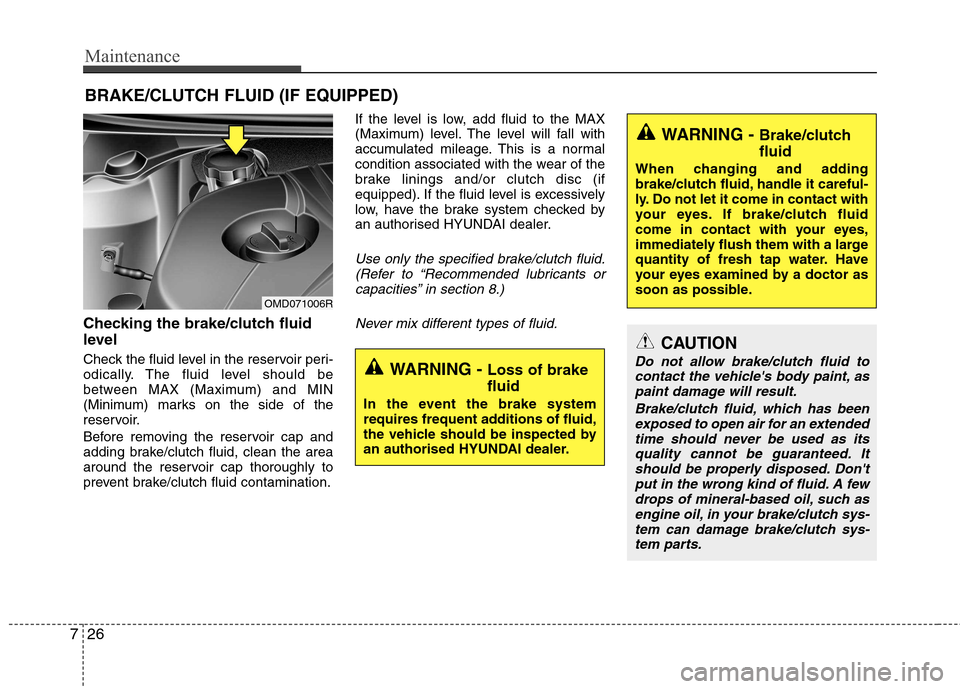
Maintenance
26
7
BRAKE/CLUTCH FLUID (IF EQUIPPED)
Checking the brake/clutch fluid
level
Check the fluid level in the reservoir peri-
odically. The fluid level should be
between MAX (Maximum) and MIN
(Minimum) marks on the side of the
reservoir.
Before removing the reservoir cap and
adding brake/clutch fluid, clean the area
around the reservoir cap thoroughly to
prevent brake/clutch fluid contamination. If the level is low, add fluid to the MAX
(Maximum) level. The level will fall with
accumulated mileage. This is a normal
condition associated with the wear of the
brake linings and/or clutch disc (if
equipped). If the fluid level is excessively
low, have the brake system checked by
an authorised HYUNDAI dealer.
Use only the specified brake/clutch fluid.
(Refer to “Recommended lubricants or
capacities” in section 8.)
Never mix different types of fluid.
WARNING - Loss of brake fluid
In the event the brake system
requires frequent additions of fluid,
the vehicle should be inspected by
an authorised HYUNDAI dealer.
WARNING - Brake/clutch fluid
When changing and adding
brake/clutch fluid, handle it careful-
ly. Do not let it come in contact with
your eyes. If brake/clutch fluid
come in contact with your eyes,
immediately flush them with a large
quantity of fresh tap water. Have
your eyes examined by a doctor as
soon as possible.
CAUTION
Do not allow brake/clutch fluid to contact the vehicle's body paint, as
paint damage will result.
Brake/clutch fluid, which has beenexposed to open air for an extendedtime should never be used as its quality cannot be guaranteed. It
should be properly disposed. Don'tput in the wrong kind of fluid. A few drops of mineral-based oil, such asengine oil, in your brake/clutch sys-
tem can damage brake/clutch sys-tem parts.
OMD071006R
Page 322 of 384
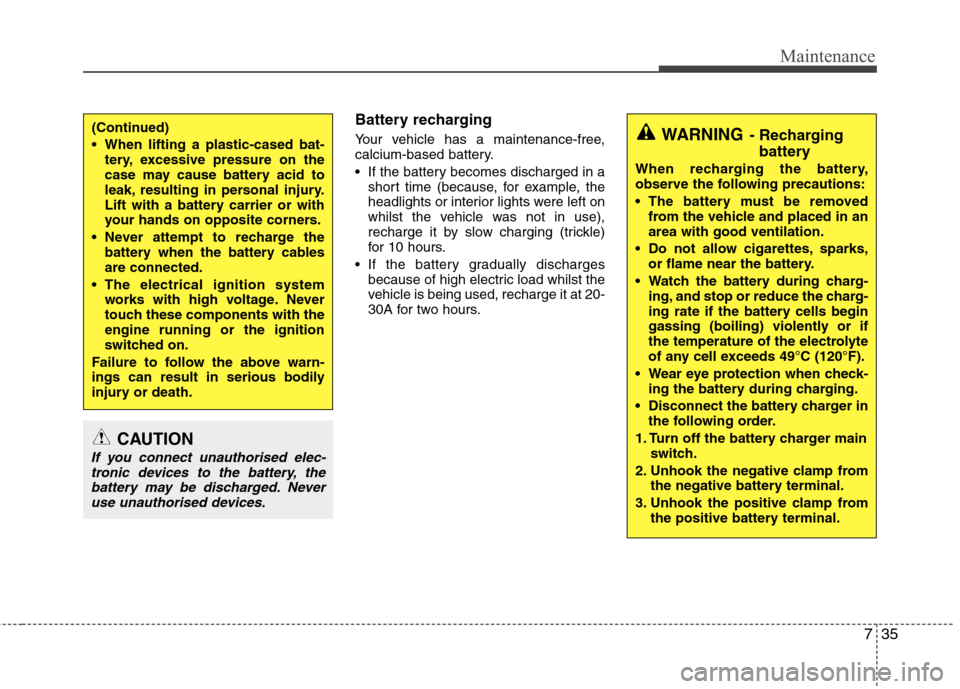
735
Maintenance
Battery recharging
Your vehicle has a maintenance-free,
calcium-based battery.
If the battery becomes discharged in ashort time (because, for example, the
headlights or interior lights were left on
whilst the vehicle was not in use),
recharge it by slow charging (trickle)
for 10 hours.
If the battery gradually discharges because of high electric load whilst the
vehicle is being used, recharge it at 20-
30A for two hours.(Continued)
When lifting a plastic-cased bat-tery, excessive pressure on the
case may cause battery acid to
leak, resulting in personal injury.
Lift with a battery carrier or with
your hands on opposite corners.
Never attempt to recharge the battery when the battery cablesare connected.
The electrical ignition system works with high voltage. Never
touch these components with theengine running or the ignition
switched on.
Failure to follow the above warn-
ings can result in serious bodily
injury or death.WARNING - Recharging
battery
When recharging the battery,
observe the following precautions:
The battery must be removed from the vehicle and placed in an area with good ventilation.
Do not allow cigarettes, sparks, or flame near the battery.
Watch the battery during charg- ing, and stop or reduce the charg-
ing rate if the battery cells begin
gassing (boiling) violently or if
the temperature of the electrolyte
of any cell exceeds 49°C (120°F).
Wear eye protection when check- ing the battery during charging.
Disconnect the battery charger in the following order.
1. Turn off the battery charger main switch.
2. Unhook the negative clamp from the negative battery terminal.
3. Unhook the positive clamp from the positive battery terminal.
CAUTION
If you connect unauthorised elec-
tronic devices to the battery, thebattery may be discharged. Never use unauthorised devices.
Page 334 of 384
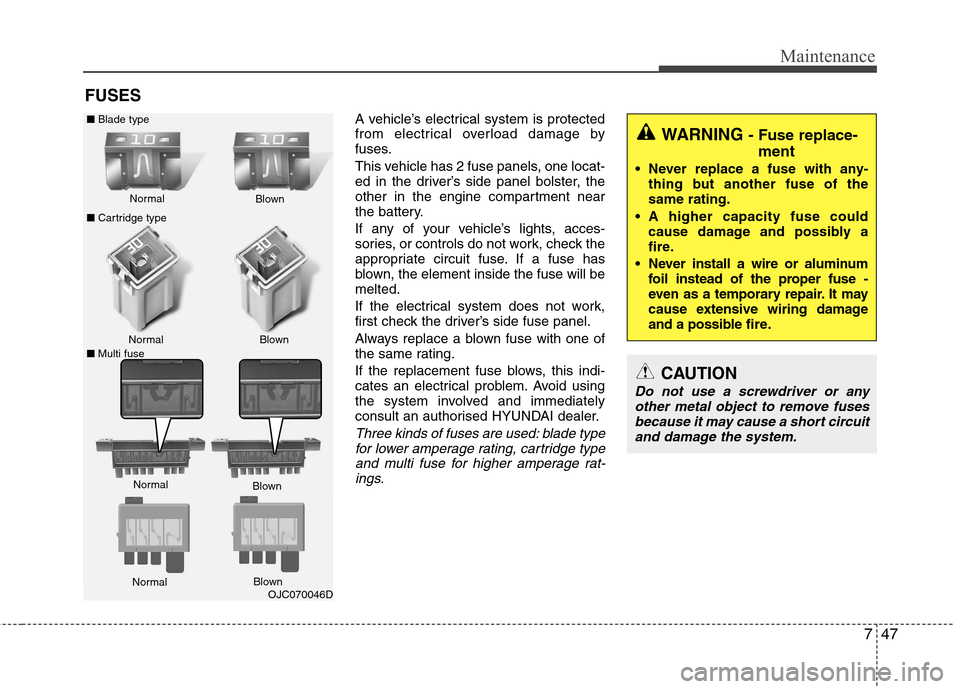
747
Maintenance
FUSESA vehicle’s electrical system is protected
from electrical overload damage by
fuses.
This vehicle has 2 fuse panels, one locat-
ed in the driver’s side panel bolster, the
other in the engine compartment near
the battery.
If any of your vehicle’s lights, acces-
sories, or controls do not work, check the
appropriate circuit fuse. If a fuse has
blown, the element inside the fuse will bemelted.
If the electrical system does not work,
first check the driver’s side fuse panel.
Always replace a blown fuse with one of
the same rating.
If the replacement fuse blows, this indi-
cates an electrical problem. Avoid using
the system involved and immediately
consult an authorised HYUNDAI dealer.
Three kinds of fuses are used: blade typefor lower amperage rating, cartridge type
and multi fuse for higher amperage rat-ings.
WARNING - Fuse replace-
ment
Never replace a fuse with any- thing but another fuse of the same rating.
A higher capacity fuse could cause damage and possibly a
fire.
Never install a wire or aluminum foil instead of the proper fuse -
even as a temporary repair. It may
cause extensive wiring damage
and a possible fire.
CAUTION
Do not use a screwdriver or any
other metal object to remove fusesbecause it may cause a short circuit
and damage the system.
OJC070046D
Normal
Normal
■ Cartridge type
■ Multi fuse Blown
Blown
Normal Blown
■
Blade type
Normal Blown
Page 335 of 384
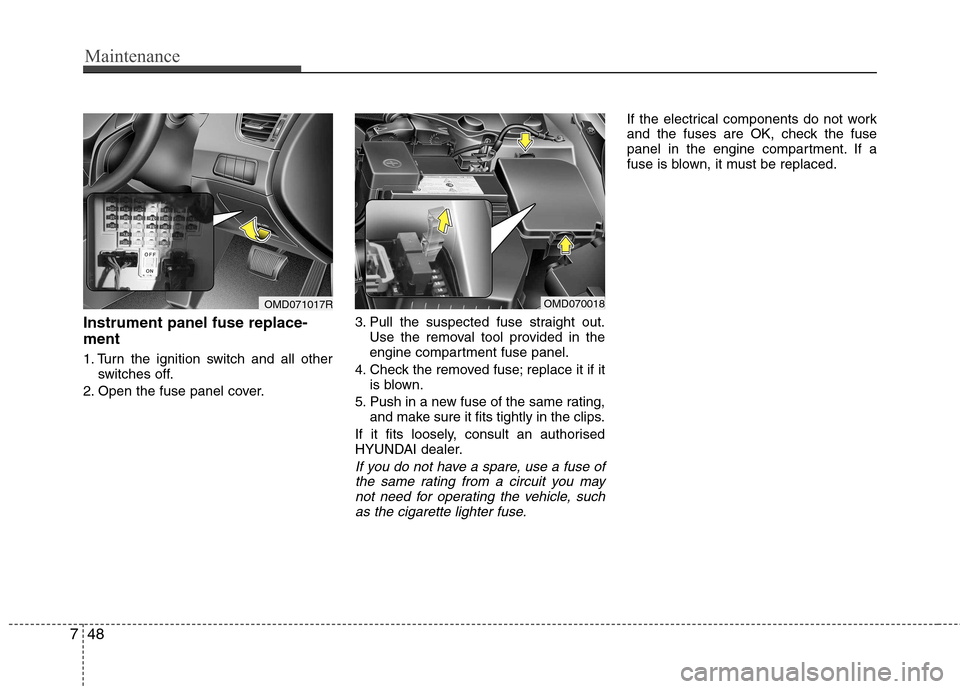
Maintenance
48
7
Instrument panel fuse replace- ment
1. Turn the ignition switch and all other
switches off.
2. Open the fuse panel cover. 3. Pull the suspected fuse straight out.
Use the removal tool provided in the
engine compartment fuse panel.
4. Check the removed fuse; replace it if it is blown.
5. Push in a new fuse of the same rating, and make sure it fits tightly in the clips.
If it fits loosely, consult an authorised
HYUNDAI dealer.
If you do not have a spare, use a fuse of the same rating from a circuit you maynot need for operating the vehicle, such
as the cigarette lighter fuse.
If the electrical components do not work
and the fuses are OK, check the fuse
panel in the engine compartment. If a
fuse is blown, it must be replaced.
OMD071017ROMD070018
Page 337 of 384
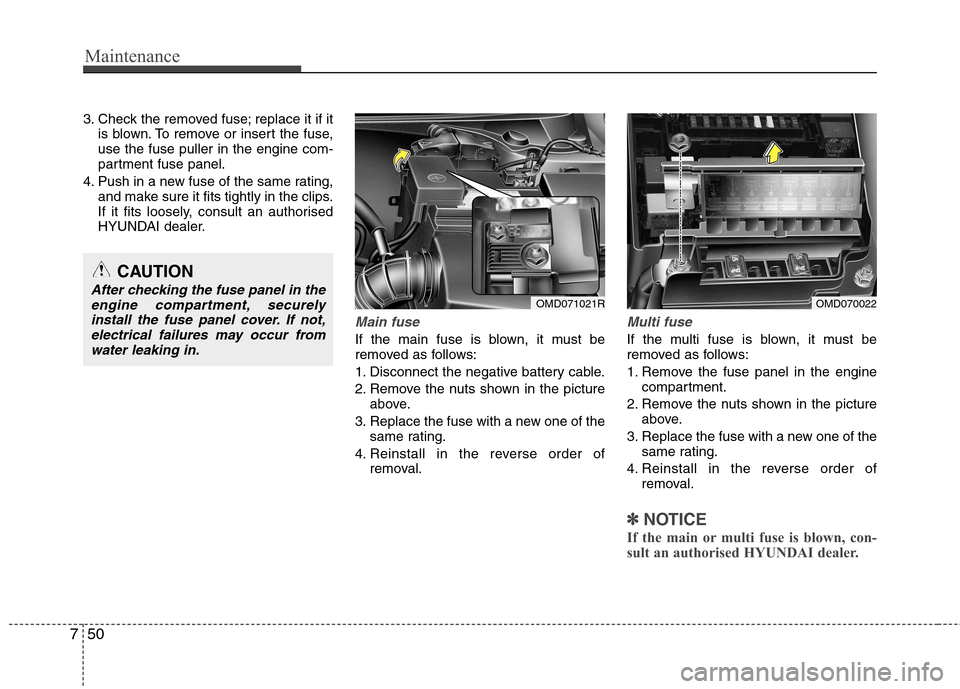
Maintenance
50
7
3. Check the removed fuse; replace it if it
is blown. To remove or insert the fuse, use the fuse puller in the engine com-
partment fuse panel.
4. Push in a new fuse of the same rating, and make sure it fits tightly in the clips.
If it fits loosely, consult an authorised
HYUNDAI dealer.
Main fuse
If the main fuse is blown, it must be
removed as follows:
1. Disconnect the negative battery cable.
2. Remove the nuts shown in the pictureabove.
3. Replace the fuse with a new one of the same rating.
4. Reinstall in the reverse order of removal.
Multi fuse
If the multi fuse is blown, it must be
removed as follows:
1. Remove the fuse panel in the enginecompartment.
2. Remove the nuts shown in the picture above.
3. Replace the fuse with a new one of the same rating.
4. Reinstall in the reverse order of removal.
✽✽ NOTICE
If the main or multi fuse is blown, con-
sult an authorised HYUNDAI dealer.
CAUTION
After checking the fuse panel in the engine compartment, securely
install the fuse panel cover. If not,electrical failures may occur fromwater leaking in.OMD071021ROMD070022
Page 342 of 384
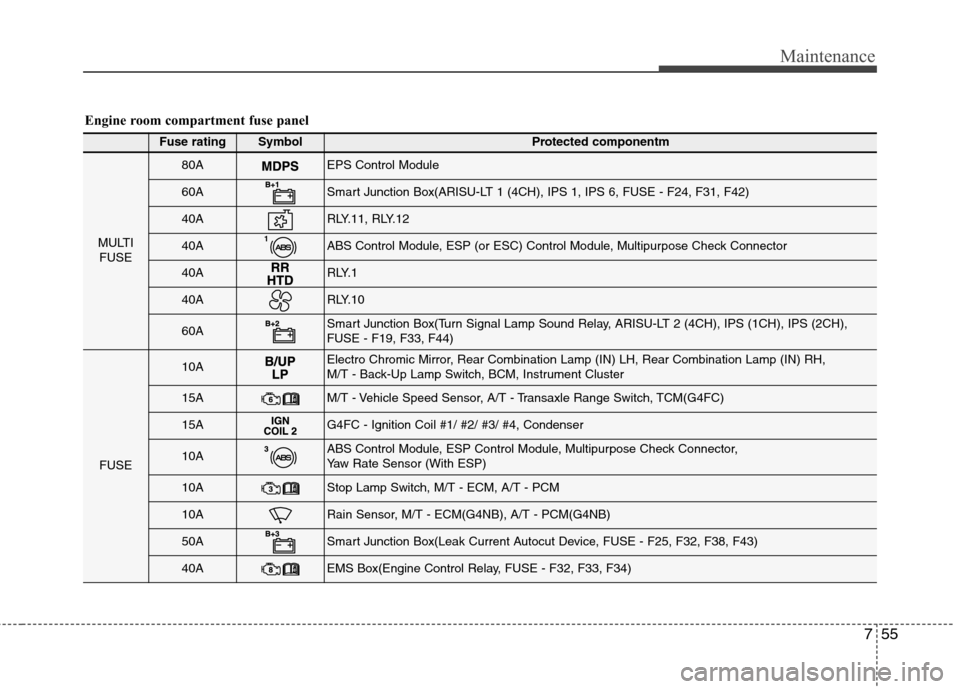
755
Maintenance
Engine room compartment fuse panel
Fuse ratingSymbol Protected componentm
MULTIFUSE
80AEPS Control Module
60ASmart Junction Box(ARISU-LT 1 (4CH), IPS 1, IPS 6, FUSE - F24, F31, F42)
40ARLY.11, RLY.12
40AABS Control Module, ESP (or ESC) Control Module, Multipurpose Check Connector
40AR LY. 1
40ARLY.10
60ASmart Junction Box(Turn Signal Lamp Sound Relay, ARISU-LT 2 (4CH), IPS (1CH), IPS (2CH), FUSE - F19, F33, F44)
FUSE
10AElectro Chromic Mirror, Rear Combination Lamp (IN) LH, Rear Combination Lamp (IN) RH,
M/T - Back-Up Lamp Switch, BCM, Instrument Cluster
15AM/T - Vehicle Speed Sensor, A/T - Transaxle Range Switch, TCM(G4FC)
15AG4FC - Ignition Coil #1/ #2/ #3/ #4, Condenser
10AABS Control Module, ESP Control Module, Multipurpose Check Connector,
Yaw Rate Sensor (With ESP)
10AStop Lamp Switch, M/T - ECM, A/T - PCM
10ARain Sensor, M/T - ECM(G4NB), A/T - PCM(G4NB)
50ASmart Junction Box(Leak Current Autocut Device, FUSE - F25, F32, F38, F43)
40AEMS Box(Engine Control Relay, FUSE - F32, F33, F34)
Page 367 of 384
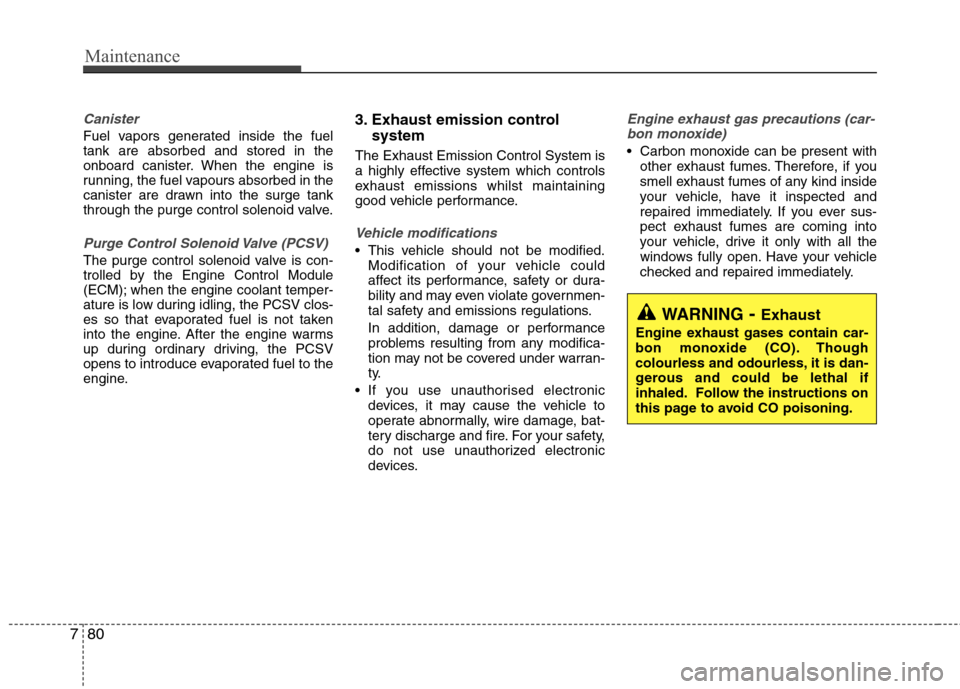
Maintenance
80
7
Canister
Fuel vapors generated inside the fuel tank are absorbed and stored in the
onboard canister. When the engine is
running, the fuel vapours absorbed in the
canister are drawn into the surge tank
through the purge control solenoid valve.
Purge Control Solenoid Valve (PCSV)
The purge control solenoid valve is con-
trolled by the Engine Control Module
(ECM); when the engine coolant temper-
ature is low during idling, the PCSV clos-
es so that evaporated fuel is not taken
into the engine. After the engine warms
up during ordinary driving, the PCSV
opens to introduce evaporated fuel to the
engine. 3. Exhaust emission control
system
The Exhaust Emission Control System is
a highly effective system which controls
exhaust emissions whilst maintaining
good vehicle performance.
Vehicle modifications
This vehicle should not be modified. Modification of your vehicle could
affect its performance, safety or dura-
bility and may even violate governmen-
tal safety and emissions regulations.
In addition, damage or performance
problems resulting from any modifica-
tion may not be covered under warran-
ty.
If you use unauthorised electronic devices, it may cause the vehicle to
operate abnormally, wire damage, bat-
tery discharge and fire. For your safety,
do not use unauthorized electronic
devices.
Engine exhaust gas precautions (car-
bon monoxide)
Carbon monoxide can be present with other exhaust fumes. Therefore, if you
smell exhaust fumes of any kind inside
your vehicle, have it inspected and
repaired immediately. If you ever sus-
pect exhaust fumes are coming into
your vehicle, drive it only with all the
windows fully open. Have your vehicle
checked and repaired immediately.
WARNING - Exhaust
Engine exhaust gases contain car-
bon monoxide (CO). Though
colourless and odourless, it is dan-
gerous and could be lethal if
inhaled. Follow the instructions on
this page to avoid CO poisoning.
Page 373 of 384
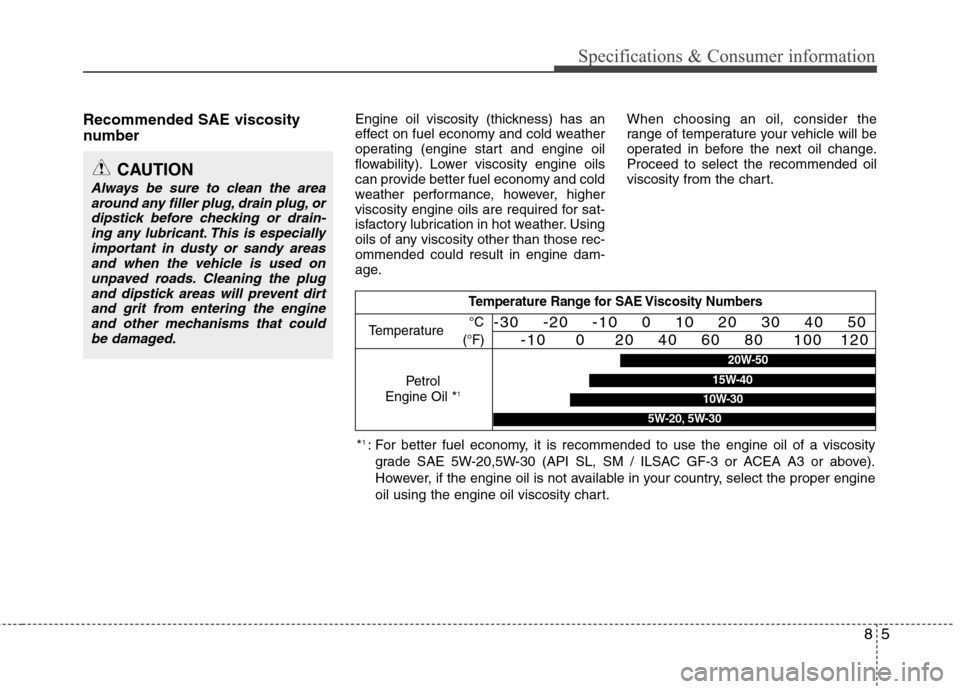
85
Specifications & Consumer information
Recommended SAE viscosity
number Engine oil viscosity (thickness) has an
effect on fuel economy and cold weather
operating (engine start and engine oil
flowability). Lower viscosity engine oils
can provide better fuel economy and cold
weather performance, however, higher
viscosity engine oils are required for sat-
isfactory lubrication in hot weather. Using
oils of any viscosity other than those rec-ommended could result in engine dam-
age.When choosing an oil, consider the
range of temperature your vehicle will be
operated in before the next oil change.Proceed to select the recommended oil
viscosity from the chart.
CAUTION
Always be sure to clean the area
around any filler plug, drain plug, ordipstick before checking or drain-ing any lubricant. This is especially
important in dusty or sandy areasand when the vehicle is used on unpaved roads. Cleaning the plugand dipstick areas will prevent dirt
and grit from entering the engine and other mechanisms that couldbe damaged.
Temperature Range for SAE Viscosity Numbers
Temperature °C
(°F)-30 -20 -10 0 10 20 30 40 50 -10 0 20 40 60 80 100 120
Petrol
Engine Oil * 1
20W-50
10W-30
15W-40
5W-20, 5W-30
*1
: For better fuel economy, it is recommended to use the engine oil of a viscosity
grade SAE 5W-20,5W-30 (API SL, SM / ILSAC GF-3 or ACEA A3 or above).
However, if the engine oil is not available in your country, select the proper engine
oil using the engine oil viscosity chart.
Page 378 of 384
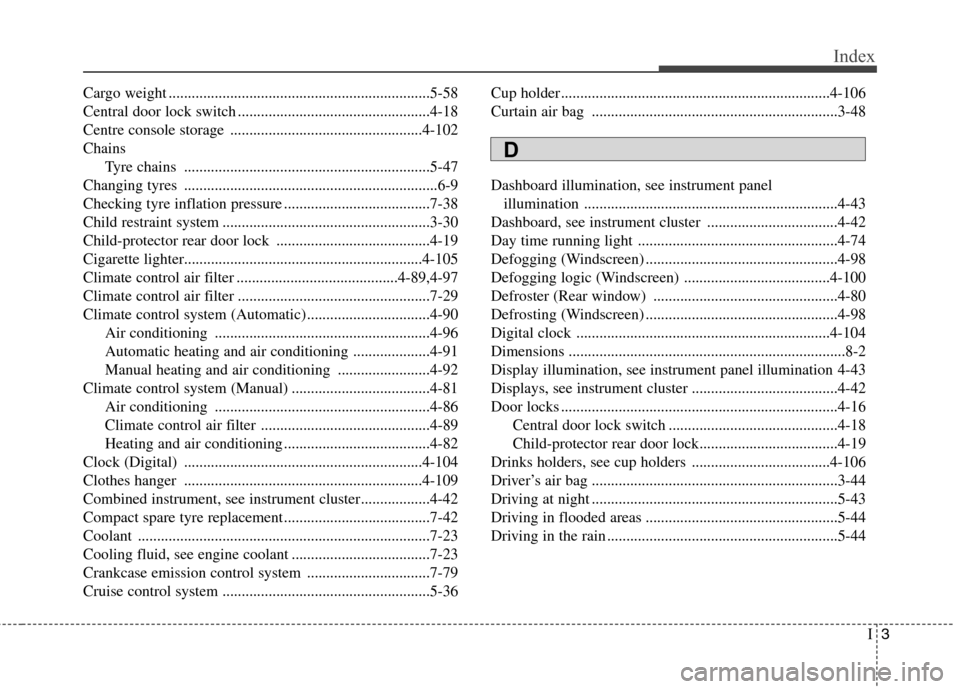
I3
Index
Cargo weight ....................................................................5-58
Central door lock switch ..................................................4-18
Centre console storage ..................................................4-102Chains
Tyre chains ................................................................5-47
Changing tyres ..................................................................6-9
Checking tyre inflation pressure ......................................7-38
Child restraint system ......................................................3-30
Child-protector rear door lock ........................................4-19Cigarette lighter..............................................................4-105
Climate control air filter ..........................................4-89,4-97
Climate control air filter ..................................................7-29
Climate control system (Automatic) ................................4-90 Air conditioning ........................................................4-96
Automatic heating and air conditioning ....................4-91
Manual heating and air conditioning ........................4-92
Climate control system (Manual) ....................................4-81 Air conditioning ........................................................4-86
Climate control air filter ............................................4-89
Heating and air conditioning ......................................4-82
Clock (Digital) ..............................................................4-104
Clothes hanger ..............................................................4-109
Combined instrument, see instrument cluster..................4-42
Compact spare tyre replacement ......................................7-42
Coolant ............................................................................7-23
Cooling fluid, see engine coolant ....................................7-23
Crankcase emission control system ................................7-79
Cruise control system ......................................................5-36 Cup holder......................................................................4-106
Curtain air bag ................................................................3-48
Dashboard illumination, see instrument panel
illumination ..................................................................4-43
Dashboard, see instrument cluster ..................................4-42
Day time running light ....................................................4-74
Defogging (Windscreen) ..................................................4-98
Defogging logic (Windscreen) ......................................4-100
Defroster (Rear window) ................................................4-80
Defrosting (Windscreen) ..................................................4-98
Digital clock ..................................................................4-104
Dimensions ........................................................................8-2
Display illumination, see instrument panel illumination 4-43
Displays, see instrument cluster ......................................4-42
Door locks ........................................................................4-16 Central door lock switch ............................................4-18
Child-protector rear door lock....................................4-19
Drinks holders, see cup holders ....................................4-106
Driver’s air bag ................................................................3-44
Driving at night ................................................................5-43
Driving in flooded areas ..................................................5-44
Driving in the rain ............................................................5-44
D
Page 383 of 384
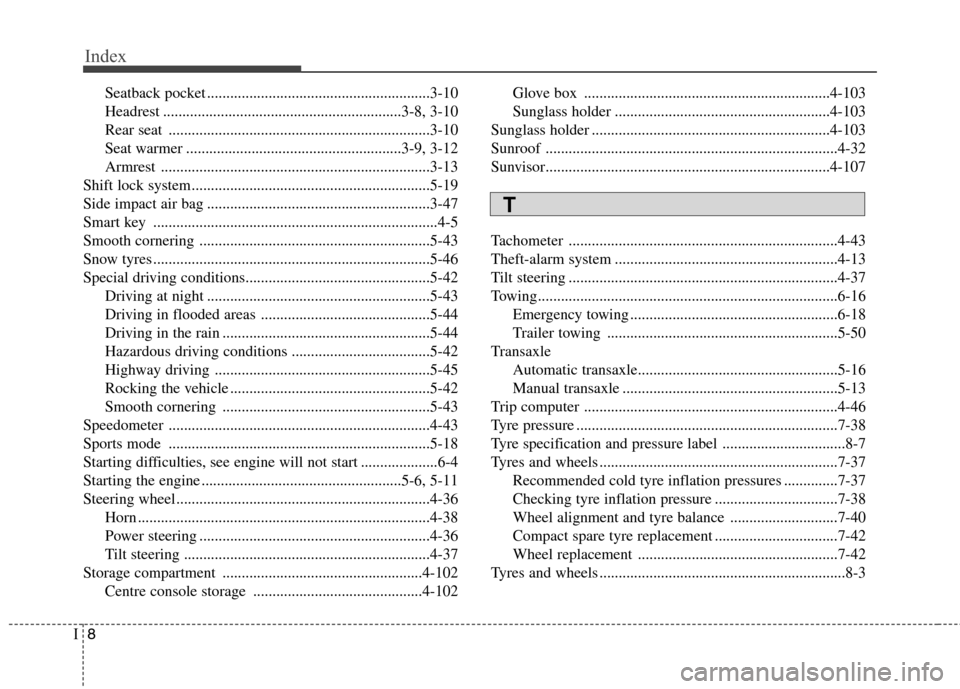
Index
8
I
Seatback pocket ..........................................................3-10
Headrest ..............................................................3-8, 3-10
Rear seat ....................................................................3-10
Seat warmer ........................................................3-9, 3-12
Armrest ......................................................................3-13
Shift lock system ..............................................................5-19
Side impact air bag ..........................................................3-47
Smart key ..........................................................................4-5
Smooth cornering ............................................................5-43
Snow tyres ........................................................................5-46
Special driving conditions................................................5-42 Driving at night ..........................................................5-43
Driving in flooded areas ............................................5-44
Driving in the rain ......................................................5-44
Hazardous driving conditions ....................................5-42
Highway driving ........................................................5-45
Rocking the vehicle ....................................................5-42
Smooth cornering ......................................................5-43
Speedometer ....................................................................4-43
Sports mode ....................................................................5-18
Starting difficulties, see engine will not start ....................6-4
Starting the engine ....................................................5-6, 5-11
Steering wheel ..................................................................4-36 Horn ............................................................................4-38
Power steering ............................................................4-36
Tilt steering ................................................................4-37
Storage compartment ....................................................4-102 Centre console storage ............................................4-102 Glove box ................................................................4-103
Sunglass holder ........................................................4-103
Sunglass holder ..............................................................4-103
Sunroof ............................................................................4-32
Sunvisor..........................................................................4-107
Tachometer ......................................................................4-43
Theft-alarm system ..........................................................4-13
Tilt steering ......................................................................4-37
Towing..............................................................................6-16 Emergency towing ......................................................6-18
Trailer towing ............................................................5-50
Transaxle Automatic transaxle....................................................5-16
Manual transaxle ........................................................5-13
Trip computer ..................................................................4-46
Tyre pressure ....................................................................7-38
Tyre specification and pressure label ................................8-7
Tyres and wheels ..............................................................7-37 Recommended cold tyre inflation pressures ..............7-37
Checking tyre inflation pressure ................................7-38
Wheel alignment and tyre balance ............................7-40
Compact spare tyre replacement ................................7-42
Wheel replacement ....................................................7-42
Tyres and wheels ................................................................8-3
T